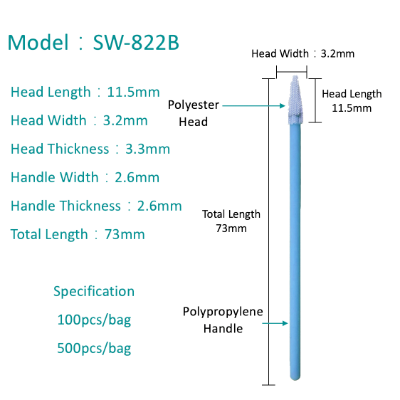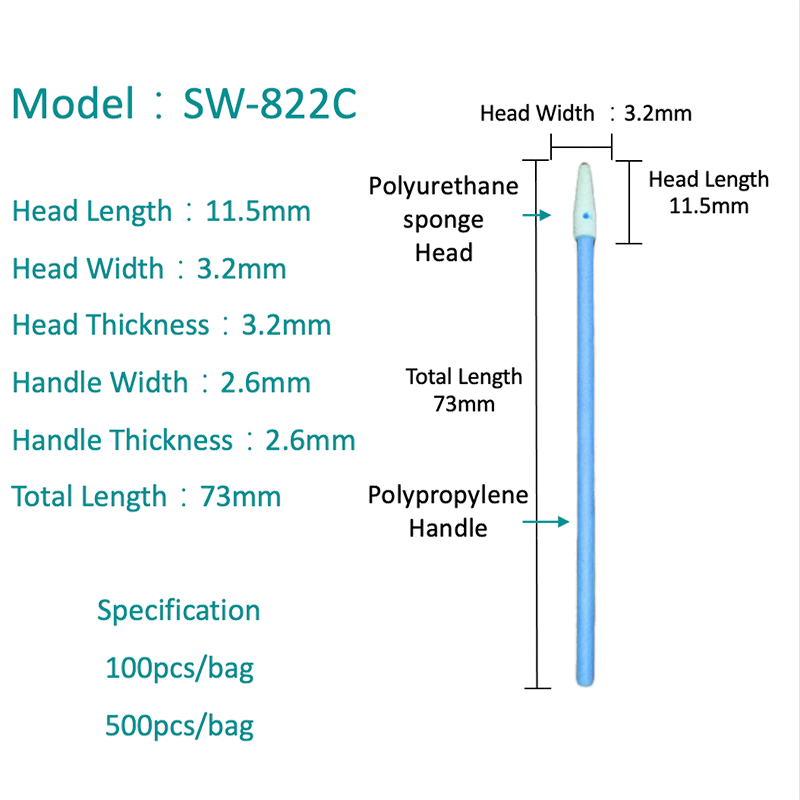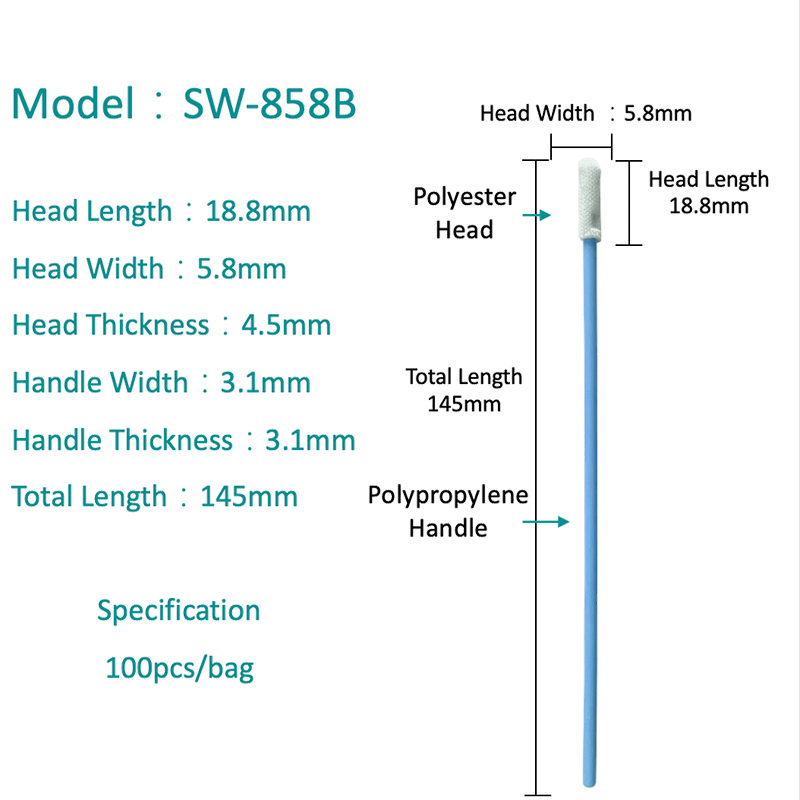HOME / NEWS / Industry News / The Ultimate Guide to Micro Polyester Foam Tip Cleaning Swabs: Selection, Applications and Best Practices
Why Micro Polyester Foam Tip Cleaning Swabs Are Essential for Precision Cleaning
In today's demanding technical environments, micro polyester foam tip cleaning swabs have emerged as the gold standard for precision cleaning applications. Unlike conventional cleaning tools, these specialized implements combine the gentle touch required for delicate surfaces with the cleaning power needed for professional results. The closed-cell structure of micro polyester foam creates a non-particulating surface that won't shed fibers or leave residue behind - a critical feature when cleaning optical lenses, electronic components, or medical devices.
Key Advantages of Micro Polyester Foam Tips
The engineered structure of micro polyester foam delivers unparalleled performance characteristics:
- Superior liquid retention capacity that prevents dripping while maximizing solution contact time with surfaces
- Consistent pore structure that provides predictable cleaning performance across entire batches
- Exceptional chemical compatibility with isopropyl alcohol, acetone, and most industrial solvents
- Thermal stability maintaining integrity across a wide temperature range (-40°F to 250°F)
- Electrostatic discharge (ESD) safe formulations available for sensitive electronics work
Material Comparison: Performance Under Microscope
When selecting cleaning tools for critical applications, material choice dramatically affects outcomes:
| Property | Micro Polyester Foam | Cotton | Cellulose Sponge | Polyurethane Foam |
|---|---|---|---|---|
| Particle Generation | 0-5 particles/cm² | 50-100 particles/cm² | 20-40 particles/cm² | 10-25 particles/cm² |
| Absorption Rate | 0.8-1.2 ml/g | 0.5-0.7 ml/g | 0.9-1.1 ml/g | 0.7-0.9 ml/g |
| Chemical Resistance | Excellent | Good | Fair | Good |
| Surface Hardness | 15-25 Shore 00 | N/A | 30-40 Shore 00 | 20-30 Shore 00 |
Top 5 Applications for high precision cleaning swabs with foam tips
The unique properties of high precision cleaning swabs with foam tips make them indispensable across multiple industries where contamination control and surface integrity are paramount. Their ability to conform to microscopic surface topography while maintaining structural integrity sets them apart from traditional cleaning tools.
1. Electronics Manufacturing and Repair
In cleanroom electronics production, these swabs address critical challenges:
- Removing ionic contamination from PCB surfaces prior to conformal coating
- Cleaning connector pin sockets without damaging spring contacts
- Precision application of flux removers in SMT rework stations
- Maintaining fiber optic connectors in telecom equipment
- Cleaning wafer handling equipment in semiconductor fabrication
Case studies in semiconductor manufacturing have shown 37% reduction in particulate contamination when switching from cotton to micro polyester foam swabs in cleanroom environments.
2. Medical Device Manufacturing and Maintenance
The medical field presents unique cleaning challenges that foam tip swabs expertly solve:
- Debris removal from laparoscopic instrument channels
- Cleaning ultrasonic transducer arrays without damaging piezoelectric elements
- Maintaining fiber optic bundles in endoscopic equipment
- Prepping surfaces for medical adhesive bonding
- Cleaning precision fluidic channels in diagnostic cartridges
3. Aerospace and Defense Applications
Aviation and military systems demand reliable cleaning solutions:
- Maintaining avionics components in flight control systems
- Cleaning waveguide interfaces in radar equipment
- Removing corrosion inhibitors prior to inspections
- Servicing night vision equipment optics
How to Choose the Best lint-free foam swabs for delicate surfaces
Selecting optimal lint-free foam swabs for delicate surfaces requires careful consideration of multiple technical parameters. The right choice depends on your specific application requirements, environmental conditions, and cleanliness standards.
Foam Density and Pore Structure Analysis
Foam characteristics dramatically affect cleaning performance:
- Low density (15-25 kg/m³): Ideal for polishing optical surfaces or cleaning fragile gold plating
- Medium density (30-45 kg/m³): Balanced for general precision cleaning of circuit boards
- High density (50-80 kg/m³): For removing cured adhesives or stubborn contaminants
Shaft Material Engineering Considerations
The swab shaft contributes significantly to cleaning effectiveness:
| Shaft Type | Flexibility | Chemical Resistance | ESD Properties |
|---|---|---|---|
| Polypropylene | High | Excellent | Non-conductive |
| ABS Plastic | Medium | Good | Static-dissipative |
| Stainless Steel | Rigid | Excellent | Conductive |
The Science Behind anti-static cleaning swabs for electronics
Anti-static cleaning swabs for electronics incorporate advanced materials science to protect sensitive components from electrostatic discharge (ESD) damage that can occur during cleaning procedures. These specialized tools maintain surface resistivities between 10³ to 10¹¹ ohms/square to safely dissipate charges.
Advanced Anti-Static Technologies
Modern ESD-safe swabs utilize multiple technological approaches:
- Carbon-loaded polymers: Uniform distribution of conductive carbon particles creates continuous discharge paths
- Ionic additives: Hygroscopic salts attract moisture to create conductive channels
- Metallic fiber blends: Micro-scale stainless steel or nickel fibers provide permanent conductivity
ESD Protection Performance Metrics
Quality anti-static swabs must meet stringent standards:
| Test Parameter | ANSI/ESD S20.20 | IEC 61340-5-1 |
|---|---|---|
| Surface Resistance | 10³-10¹¹ Ω/sq | 10⁴-10¹¹ Ω/sq |
| Charge Generation | <100V | <200V |
| Decay Time | <2.0s | <2.0s |
Proper Techniques for Using microfiber foam swabs with plastic handles
Mastering the use of microfiber foam swabs with plastic handles requires understanding both material properties and application physics. Proper technique maximizes cleaning efficiency while minimizing the risk of surface damage or contamination.
Advanced Cleaning Motion Dynamics
Optimal cleaning patterns vary by application:
- Spiral motion: For circular components like lens surfaces
- Linear strokes: Best for connector pin cleaning
- Dabbing technique: For absorbing spills or excess fluids
- Rolling contact: Maintains constant fresh foam contact
Fluid Dynamics in Swab Applications
Understanding liquid interaction improves results:
- Capillary action draws contaminants into foam structure
- Optimal wet-out occurs at 60-70% saturation
- Surface tension effects can be modified with surfactants
- Viscosity affects penetration into foam matrix
Maintenance and Storage Protocols for Optimal Performance
Proper handling and storage of precision cleaning swabs preserves their performance characteristics and prevents contamination.
Controlled Environment Storage Solutions
Ideal storage conditions include:
- Class 1000 cleanroom packaging for critical applications
- Humidity control (30-50% RH) to maintain anti-static properties
- UV-protected containers to prevent material degradation
- First-expired-first-out (FEFO) inventory management
Swab End-of-Life Indicators
Recognizing when to replace swabs prevents quality issues:
- Foam compression exceeding 15% of original thickness
- Visible chemical degradation or discoloration
- Changes in surface tack or texture
- Reduced absorption capacity (>20% decrease)




 English
English  中文简体
中文简体 









